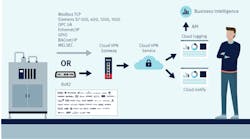- What HMI-software technologies are being used to connect edge devices and machines to the operators, supervisors and managers in the plant?
- How can HMI software be used to analyze the data to create actionable information that can be used to improve equipment?
-
How do I keep the HMI application secure while providing remote viewing of the application?
The human-machine interface (HMI) is the window to the equipment’s operations. As remote connectivity and data sharing continue to play larger roles, machine builders capitalize on the HMI’s digital capabilities. This select panel of experts discusses where HMI software is leading operator interface, as well as the equipment it puts a face on.
What are some of the latest and greatest trends in HMI software today?
Lee Clore, Onyx Industries: HMI software advances have propelled HMIs well beyond their original function of replacing push buttons and posting ASCII status messages.
Inexpensive HMIs regularly include database-driven recipe functions, advanced alarming/reporting, conditional logic/scripting and Web publishing. The HMI is often a better place to handle these control functions than inside of the PLC, getting more done with less software. In the case of robotics or dedicated motion controllers, it may be the only place to provide these control functions.
Recipes store machine run-time variables in tables and usually consist of data of different types. This could include ints, floats, bits and string data. Manufacturers of HMIs provide software that includes a database for efficient storage of large recipes. Recipes are designed for organizing database records with data of different types. The recipe data may be transferred to one or more PLCs or motion controllers allowing centralized storage of recipe data in a distributed control environment.
In the old days, HMI software offered trending, which showed the last few minutes of data in a moving graph. Now many HMI companies offer time-interval or event-based data logging to SD memory cards storing vast amounts of data.
HMI software vendors are expanding use of ladder-logic engines capable of running small logic programs in the background from the GUI. This allows high-level functions to be executed at the HMI device. Some HMIs allow scripting using Basic-like, C or Java languages. Using this, integrators can tailor the solution they offer their clients. It might be something simple like a routine to parse bar code data or a more complex recipe lookup to make sure the operator doesn't duplicate an existing recipe when setting up a new job.
Many HMIs on the market offer dynamic HTML Web publishing, allowing access to the HMI, and therefore the machine, from anywhere. An integrator who’s deployed a machine hours away can log in and help to troubleshoot. A production scheduler can log in to see current production part counts. Maintenance can log in to check service intervals programmed in PLCs accessible via the HMI. Some even allow camera connections providing video feed out for visual aid in troubleshooting remotely.
While HMI software development has advanced dramatically in recent years, it's not over. The Industrial Internet of Things, wireless and Internet security will continue to push software boundaries.
Lee Clore is owner/controls designer at Onyx Industries.
OPC UA is looking to be the automation market's communications interface of choice between smart devices, controllers, HMI and edge/fog/cloud. Also consider what OMAC is doing—a companion specifications for both MTconnect and ISA TR88 (PackML) and OPC UA. Now you'll have the benefit of a PackML state model on each HMI for a common look and feel, plus M2M communications. OMAC also has a new HMI template, based on work developed by Nestle, that puts commonly used functions such as software buttons surrounding the main HMI touch screen, so operators always know where to find core functions, regardless of make or model. The icing on the cake is OMAC also has a stack-light template corresponding to TR88 states. It’s simple and simply brilliant.
Another IIoT capability to implement on HMI is the machine's digital twin, allowing more simulation, modeling and updates machine-side.
John Kowal is director, business development at B&R Industrial Automation.
Chris Harris, PE, is senior project engineer at Revere Control Systems and a Control System Integrators Association (CSIA) member.
Allan Evora, Affinity Energy: Today's most significant trends in HMI software surround analytics, the cloud, and security. All three are related. Today's operators are expected to not only keep facilities and processes up and running, but also make decisions that impact the bottom line. IIoT creates a much richer data set for making both operational and business decisions. Connectivity to the public, private or hybrid cloud allows complex analysis with results pushed back down to the edge. This cloud connectivity, in addition to the growing need for HMI software to support mobile, has put an intense focus and concern on security.
Allan Evora is president of Affinity Energy and a CSIA member.
Chuck Harrell is key account and product marketing at Advantech.
Alicia Millinger, GE Digital: We are at a transition point in being able to leverage the Industrial Internet for the HMI/SCADA system and bring it forward into new, fourth-generation technology that makes the operator the center of the universe. By leveraging the Industrial Internet, we can have a closed loop from the operator to the cloud and analytics and back to the operator, optimizing performance.
Many users underestimate the importance of a good HMI design. The goal is simple: Operators should be able to recognize which information needs their attention and what it indicates at a glance. For that, the operator not only needs a good user interface but a system that delivers a great user experience. Efficient HMI is all about facilitating the operator’s situational awareness. Situational awareness is the ability to identify, process and comprehend the critical elements of information about what is happening. More simply, it’s knowing what is going on around you.
We have equipped the operators with eye-trackers in order to measure various parameters such as navigation time—the time they spend browsing for information, areas of the screens which are focal points for them. The results are represented under the form of heat maps on each of the screens.
Alicia Millinger is marketing manager, automation software at GE Digital.
Vikram Kumar is president/CEO of EZAutomation.
Ramey Miller, Siemens: One of the trends today is automatic object creation based on other objects or code external to the HMI itself. When multiple repetitive objects need to be displayed but the data behind is to different data elements, the time to create these elements goes up; plus possible errors can be made. Having the ability to dynamically generate a consistent screen object and map the data behind the animation to the correct elements becomes important and efficient.
Ramey Miller is HMI product manager at Siemens.
Allen Tubbs is product manager, automation and electrification solutions at Bosch Rexroth and a CSIA member.
For security, trends are affecting authentication, authorization, user groups, password policies and logs. Remote access is facilitating secure, read-only or read/write access to an HMI as if one were local to the HMI. For preventive maintenance, it’s enabling temperatures, operating hours, CPU performance history, storage and memory usage, power cycles and display usage.
Cloud options to be aware of are storage and aggregation of collected data, preventive-maintenance information, dashboard views via Web-enabled devices, firmware and project updates.
Jeff Hayes is regional product manager at Beijer Electronics.
ALSO READ: HMI software often starts with the hardware
Chirayu Shah, Rockwell Automation: The latest generation of HMI software helps manufacturers to converge IT and OT systems to reduce deployment inefficiencies and gain better access to information once buried in operations. When an HMI can directly connect with a controller, the traditionally lengthy and error-prone process of design becomes a thing of the past. HMI developers can now directly access tag descriptions, engineering units and minimum/maximum settings, saving hours and sometimes days of effort.
What’s powering this change is that engineers designing the displays or content can repurpose a lot of the work done for the control layer. When designing an alarm in the HMI, for instance, they can reference the definition of an alarm directly from the controller, helping to eliminate the need to reconfigure that alarm. When an alarm occurs, it’s more accurate because the controller is providing the time stamps and controlling other alarms on the plant floor so they don’t get out of sequence.
The anywhere, anytime workforce has also directed where HMI software is headed. Mobile solutions scale the display and content to the device. Operators have instant access to information with responsive, configurable views that can be tailored to their preferences. Operators can acknowledge or shelve an alarm notification from within the app.
Centralizing HMI content management and visualization while reducing hardware and operator costs has also become a focus for many manufacturers. Thin client software turns display content into an information layer that fluctuates depending on the operator’s need. An engineer who is servicing a terminal, for instance, will only receive the instructions and displays relevant to the role and the job being performed.
Chirayu Shah is marketing manager, HMI software, at Rockwell Automation.
Asako Takayasu, Fuji Electric: We believe cloud service is becoming the trend. You can store various kinds of data such as logging, alarm and operation log in the cloud server. If you have multiple plants worldwide, you can keep all data in one location and the authorized managers will have an access to the server and can easily use them for analysis or troubleshooting to identify problems and share the improvement simultaneously.
Asako Takayasu is international product specialist, HMI, at Fuji Electric.
Mike Bacidore is the editor in chief for Control Design magazine. He is an award-winning columnist, earning a Gold Regional Award and a Silver National Award from the American Society of Business Publication Editors. Email him at [email protected].



















